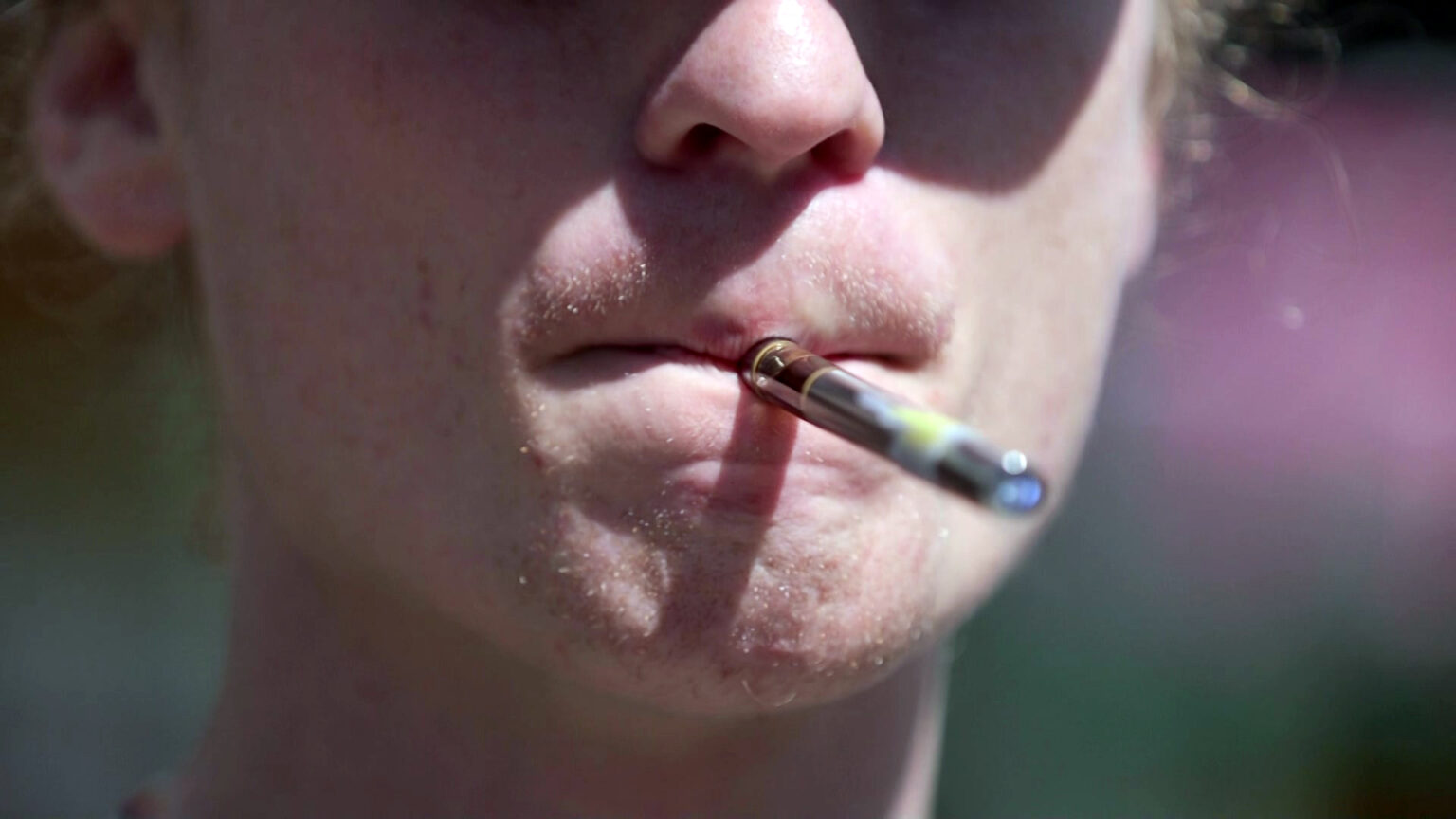Vaping down among Wisconsin teens, while underage sales rise under new law
The percentage of teens in Wisconsin who have reported using e-cigarettes has fallen since the federal government in 2019 raised the legal age for purchasing nicotine products from 18 to 21.
Wisconsin Watch
January 17, 2024

A man vapes on Sept. 18, 2019. As of 2022, an estimated 1 in 10 Wisconsin high school students reported using e-cigarettes (Credit: PBS Wisconsin)

This article was first published by Wisconsin Watch.
Connor Meinken, 24, used an e-cigarette for a year during high school in Wilmot. His friends at the time did too. Now, six years later, he has quit for good — but the majority of his friends have not. For them, their underage e-cigarette use has spiraled into a years-long addiction.
Starting to vape “wasn’t a good idea at all,” Meinken said. “I just never saw it ending.”
The e-cigarette arrived on the American market in the mid-2000s, exchanging the smelly secondhand smoke and cumbersome packaging of a traditional cigarette for a pocket-sized device with a quickly dissipating scent. In 2014, it became the nicotine carrier of choice for American teens — accompanied by a media storm of concern.
As of 2022, an estimated 1 in 10 Wisconsin high school students reported using e-cigarettes, similar to what the CDC’s National Youth Tobacco survey found nationwide. That’s down from 1 in 5 in 2018, a year before the federal government raised the legal age for buying nicotine products from 18 to 21.
Cigarette use also continues to drop with only 1.8% of high school students in Wisconsin reporting regular use in 2022, down from 4.7% in 2018 and 10.7% in 2014.
Still, growing percentages of Wisconsin retailers are selling nicotine products to underage buyers since the legal age changed, survey data show — signaling that some may not recognize the new law.
When first released, e-cigarettes experienced a growth unlike any other tobacco product, said Luke Witkowski, youth programs coordinator for the Wisconsin Department of Health Services’ Tobacco Prevention and Control program. In less than two decades, vaping has amassed a market value of $8.3 billion in the United States alone. That’s about 10% of the $82.7 billion cigarette industry.
“We had never seen anything like it,” Witkowski said.
Meinken’s parents figured it was just a passing fad with his generation. But experts say the habit is far from harmless.
Young people who vape often develop a predisposition to nicotine, which can have long-term consequences. E-cigarettes contain much higher concentrations of nicotine than a traditional cigarette, often equaling a pack or more in a single cartridge. Research has shown that e-cigarette users are generally more reliant on consistent nicotine ingestion than cigarette users.
“(Nicotine) literally alters the makeup of the brain as it’s developing,” explained Chris Hollenback, the communications director for the University of Wisconsin-Madison Center for Tobacco Research and Intervention.
Before the brain is fully formed, addictive substance use induces growth of additional receptors that control the release of dopamine — a hormone that regulates feelings of pleasure and helps create associations between certain behaviors and outcomes.
“You have these receptors saying ‘more, more, more,'” Hollenback continued. “When you’re under the age of 17, it’s easier to get addicted and harder to quit.”
E-cigarette use before the brain is fully developed can also result in cognitive deficits, impairment in memory and executive function, and possibly hyperactivity and impulsive behavior changes, according to a study published in the Missouri Medicine journal.
What is an e-cigarette and what are its dangers?
E-cigarettes operate by heating liquid in a metal coil and transforming it into a vapor inhaled into the lungs. The primary component of the liquid is either nicotine or THC, which is then infused with chemical flavors and additives. Drug-free e-cigarettes are also available.
When first introduced, e-cigarettes were intended for use as a tobacco cessation aid. However, according to research carried out through reviews of Twitter posts in 2015, fewer than 29% of e-cigarette users did so to help stop smoking, down from 43% in 2012.
For adults who switch away from traditional cigarettes, the path to quitting entirely is often unclear. Up until he quit nicotine, Cory Richardson, 42, of Oconomowoc, used roughly one JUUL pod a day for the last seven years. He initially turned to the tobacco-flavored vaporizer as an alternative to Camel and Marlboro cigarettes but said he gradually ended up smoking just as much because of the accessibility of vapes.
“I would wake up and it’s right on my bedside table. I would just wake up and look over and I got the vape in my hand,” Richardson said. “It’s not like you just grab a pack of cigs and you know, in your sleep go outside to smoke. It was like a muscle memory thing with the vaping because it was just all the time.”
In the days after he quit, Richardson said he experienced more severe withdrawal symptoms than when he previously stopped using alcohol and marijuana.
“It just almost made me feel like a different person. Like I was always angry. Like it was just a switch turned on and from when I woke up until I went to sleep, I just felt like my mood was in a negative spot always,” Richardson said, adding that he was still experiencing withdrawal symptoms. “I keep feeling like I should be hitting this stupid little pen.”
In the short term, experts suggest vaping is safer overall than smoking a cigarette. A cigarette produces more than 7,000 chemicals when smoked, many of which are toxic. Vapes, comparatively, expose users to closer to 2,000.
“It’s only healthier than cigarettes,” Meinken said, recalling that the logic appealed to his still-developing teenage brain. “It’s still not healthy.”
Regulatory picture on vapes murky
The Food and Drug Administration struggles with e-cigarette regulation.
“We have found products on the market for which the company never submitted an application,” said Mitch Zeller, director of the FDA Center for Tobacco Products. Others have been released pending approval of an application that the center hasn’t reviewed yet.
As of 2020, the CDC confirmed 2,807 vaping-related lung injuries following a national wave of hospitalizations. In July 2020, eight Milwaukee-area teenagers were admitted to Children’s Hospital of Wisconsin for the same reason. The major cause of this injury was vitamin E acetate, a thickening agent used in some THC e-cigarettes.
Although vitamin E acetate has since been phased out of many commercial vapes, there are numerous chemicals produced by e-cigarettes that have not yet been fully identified and could be harmful. And little is known about the long-term effects of vaping because the product hasn’t been around for long enough to find out.
Why do teenagers use e-cigarettes?
For Meinken, the allure of vaping outstripped the uncertainty over its dangers.
“We weren’t smart enough to know what we were doing,” he said. “We knew it wasn’t good, but you wanted to try the flavors, you wanted to try to blow the biggest smoke cloud ever.”
DHS has highlighted several reasons for e-cigarette popularity among young users, including marketing and a wide array of flavor choices — from fresh mint to tropical fruit. They’re also easily concealed due to both their limited scent and small size, meaning they can be easily brought into schools.
Meinken said he developed an oral fixation after he started vaping.
“I would bite my fingernails, I would just chew on stuff,” Meinken said. “It was another kind of sign … that it was changing me in ways I didn’t really like.”
Meinken said he and his friends would “chuck” clouds, referring to the practice of blowing as large a smoke cloud as possible. Experts say overconsumption of the chemical in that way can cause nicotine poisoning. Symptoms range from nausea and vomiting to trouble breathing and, in very rare cases, death.
When Meinken was in high school, the legal age to purchase e-cigarettes was 18. Local establishments, he said, were lax on controlling sales to minors.
“There were gas stations (that sold e-cigarettes) right outside our high school,” he explained. “They were also run by teenagers.”
Legal age for nicotine products now 21
In 2019, President Donald Trump signed a federal law raising the minimum age to purchase nicotine products to 21. That corresponds with fewer teens saying they use tobacco and e-cigarettes.
But sales to underaged buyers have increased since the change, surveys show, signaling lingering confusion.
Wisconsin’s estimated violation rate for underage tobacco and e-cigarette sales reached 13.6% in 2023, DHS announced in November. That was up from 11.9% a year earlier and 5.5% in 2019. The rate is calculated from an annual survey in which young people are dispatched to attempt to buy nicotine products.
The data through 2019 included sales to people under 18. The three most recent surveys measured sales to participants under 21.
DHS launched a campaign in November to boost awareness of the legal age change, and it says that changing Wisconsin’s legal age from 18 to match the federal age of 21 could help, even though federal law takes precedence.
“Wisconsin remains one of only eight states that has not changed its state law to match the federal law, which has caused confusion and enforcement challenges statewide,” DHS said in a November press release.
Company accused of targeting kids
The FDA issued its first warning letters about underage e-cigarette sales in 2016. Shortly afterward, controversy erupted around e-cigarette company JUUL’s alleged targeting of children.
JUUL is still answering to lawsuits over its marketing tactics. Minnesota recently settled its case against the company, though the terms of the settlement remain private. Wisconsin in September settled a case alongside 32 other states against JUUL for a total payout of nearly $440 million, of which the Badger State received a $14.7 million share.
The teenagers who used e-cigarettes in the mid-2010s are now young adults. Some, like Meinken, kicked the habit. But others continue to use nicotine.
“We might be causing the next smoking epidemic through young people getting addicted to electronic cigarettes early in life,” said Michael Blaha, a Johns Hopkins University professor of medicine.
How can teenagers stop their nicotine use right now?
Nicotine has been found to be as addictive as cocaine and heroin. The CDC reports “fewer than one in 10 adult cigarette smokers succeed in quitting each year.”
There are tobacco cessation programs available in Wisconsin and nationwide to help teenagers quit.
The Wisconsin DHS funds four programs for teenagers: Not on Tobacco (N-O-T), NOT for Me, Live Vape Free and the Wisconsin Tobacco Quit Line. Each one is free to access. They provide texting services and in-person group meetings, though Witkowski said those services are little used.
“Young people are choosing to address their addiction on their own,” he said. “Trying to do that … is incredibly overwhelming.”
He said many teenagers lack trusted adult sources to overcome addiction issues. One campaign, Their Tobacco is Changing, aims to help educate parents and guardians on the e-cigarette market to offer better guidance to their children.
National programs, like the Truth Initiative’s free texting service This is Quitting, are also available. Over 580,000 young people have signed up for the service.
Medical cessation options such as nicotine patches and gum could also help, though purchase is usually limited to adults. Teenagers can, however, approach medical professionals to ask about medication and prescription options for cessation instead.
Find resources
The Wisconsin Department of Health Services recommends the following resources for those wanting to quit nicotine use:
- WI Tobacco Quit Line offers customized plans and coaching for ages 13 and up. Call 800-784-8669, or text “READY” to 34191.
- Live Vape Free offers text support to quit e-cigarettes for ages 13 to 17. Text “VAPEFREE” to 873373.
- American Indian Quit Line offers culturally tailored coaching to those aged 18 and up. Call 1-888-724-7848.
- First Breath offers support during and after a pregnancy for ages 18 and up.
The nonprofit Wisconsin Watch collaborates with WPR, PBS Wisconsin, other news media and the University of Wisconsin-Madison School of Journalism and Mass Communication. All works created, published, posted or disseminated by Wisconsin Watch do not necessarily reflect the views or opinions of UW-Madison or any of its affiliates.
 Passport
Passport











Follow Us